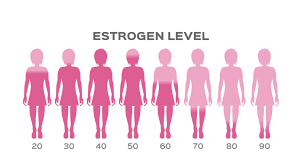
Estrogens are hormones that are primarily important for reproductive and sexual development in women. They are also called female sex hormones. The term “estrogen” carries all the chemically similar hormones of this group, such as estrone, estriol, and estradiol. This hormone is produced from cholesterol by the ovaries of women every month. Estrogen reaches all organs and tissues through the blood and is metabolized by enzymes in the liver.
Estrogen is produced by the ovaries and, to a lesser extent, the adrenal cortex (the outer part of the adrenal gland at the top of each kidney), the testes, and the fetal and placenta (Fetoplacental unit).
Estrogen dominance is prominent in hormone imbalances in both men and women. Estrogen preponderance occurs when the ratio of progesterone is much higher than that of estrogen in some way. In estrogen dominance, there is also an increased level of estrogen compared to progesterone, but much less so.
Estrogen imbalance
In women, the reproduction process is promoted by fluctuating estrogen and progesterone levels from the beginning of menstruation to menopause. Around the age of 35 to 40, most women go through a stage of premenopause. This is due to fluctuations in progesterone and estrogen levels.
From the start of premenopause until the age of 50, there is a decrease of approximately 35% in estrogen levels as well as a 75% decrease in progesterone levels. But this is considered normal. Although estrogen and progesterone depend on each other. This type of decrease in progesterone production produces symptoms of estrogen dominance. Then why the estrogen levels are not already low. Women may also experience increased estrogen levels, with normal or low levels of progesterone. It is also considered estrogen primacy. For women, it is more common in menstrual years.
Types of estrogen hormone
There are three types of estrogen hormones:Estrone (E1): This main form of estrogen is produced during menopause. It is made in your liver and fat cells because toxins such as Xenoestrogens, heavy metals, and other pollutants, etc. factors that affect hormone levels, are collected in your liver and fat cells.
Estradiol (E2):
Most of the estrogen is produced in the ovaries. These hormones play an important role in energy, sleep, pleasure, sex and healthy bones and hair. It also helps in providing moisture to the skin, lips, eyes and vagina. Estradiol is a very good growth stimulant and its increased levels increase the risk of cancer in the breast or uterus. (Read more – sex kaise karte hain)
Estriol (E3):
It is formed in liver and breast cells. Primarily it is produced by Placenta during pregnancy. It is believed that this form of estrogen (estriol) is also used to detect which cells are working for estrogen and which are not. It is a highly protective form of estrogen that reduces cells’ growth factors and excess estrogen. Estriol reduces excess estradiol and protects breasts from carcinogenic radiation.
Normally 90% estriol, 7% estradiol and 3% estrone should be present in the body.

Read more:How to increase the Estrogen hormone levels
Symptoms of low estrogen hormone levels
Girls who have not had puberty and women who are about to have menopause are likely to have lower estrogen hormone levels but can develop estrogen in women of all ages.
The following symptoms of low levels of estrogen hormone are:
1. Experiencing pain during sex due to lack of vaginal lubrication.
2. Increased urinary tract infection (UTI) due to thinning of the urethra. (Read more – Due to urine infection)
3. Irregular menstruation.
4. Change the mood.
5. Hot flashes
6. Breast discomfort.
7. Headache or pre-existing migraine.
8. Depression (depression). (Read more – Desi Cures of Depression)
9. Decrease in concentration.
10. Fatigue. (Read more – What to eat to relieve fatigue and strength)
11. Fracture or more easily fracture in your bones can be caused by a decrease in bone density. Estrogen works together with calcium, vitamin D, and other minerals to keep bones strong. If your estrogen hormone levels are low, your bone density may decrease.
If no treatment is done when estrogen hormone levels are low, it can cause infertility problems in women.
Low levels of estrogen hormone
Estrogen hormone is mainly produced in the ovaries, therefore factors affecting ovulation also affect estrogen production.Young women may experience a decrease in estrogen hormone levels for the following reasons:
1. Insanity workout
2. Dietary disorders such as anorexia (loss of appetite)
3. Less useful pituitary gland
4. Premature ovarian failure, which can be caused by heredity, toxins, and autoimmune problems.
5. Turner syndrome (Girls with this tend to be younger and their ovaries do not work properly.)
6. Chronic kidney disease
7. A decrease in estrogen levels in women over 40 years of age may be a sign of menopause.
8. Your ovaries also produce estrogen during perimenopause. It will continue to be produced slowly until menopause. When the production of estrogen stops, you have menopause.
Symptoms of low estrogen hormone levels
Girls who have not had puberty and women who are about to have menopause are likely to have lower estrogen hormone levels but can develop estrogen in women of all ages.

Estrogen therapy
In women between 25 and 50 years of age, high levels of estrogen are prescribed for them when estrogen levels are low. It reduces the risk of bone loss, heart disease, and other hormonal imbalances.
The actual amount of estrogen depends on the severity of the disease and the method of dosage. Estrogen can be transported in the body in the following ways:
1. By mouth (Orally)
2. Topically
3. Vaginally (Vaginally)
4. Through injection
In some cases, long-term treatment is required even when estrogen levels are normal. Estrogen therapy may reduce the severity of menopausal symptoms and the risk of fractures.
Long term estrogen therapy is the primary treatment for women who are undergoing menopause or have undergone hysterectomy. In all other cases, estrogen therapy is performed only for one to two years as it may also increase the risk of cancer.
Hormone replacement therapy (HRT)
HRT is used to increase your body’s natural hormone levels. If your menopause is near, doctors may recommend HRT. Menopause continuously lowers estrogen and progesterone levels. HRT helps normalize these levels.
In this therapy also, estrogen is transported in the body in the same manner as above.
Women who are given HRT treatment for the treatment of menopause may have an increased risk of heart diseases. This treatment can cause diseases such as blood clotting, stroke, and breast cancer.
